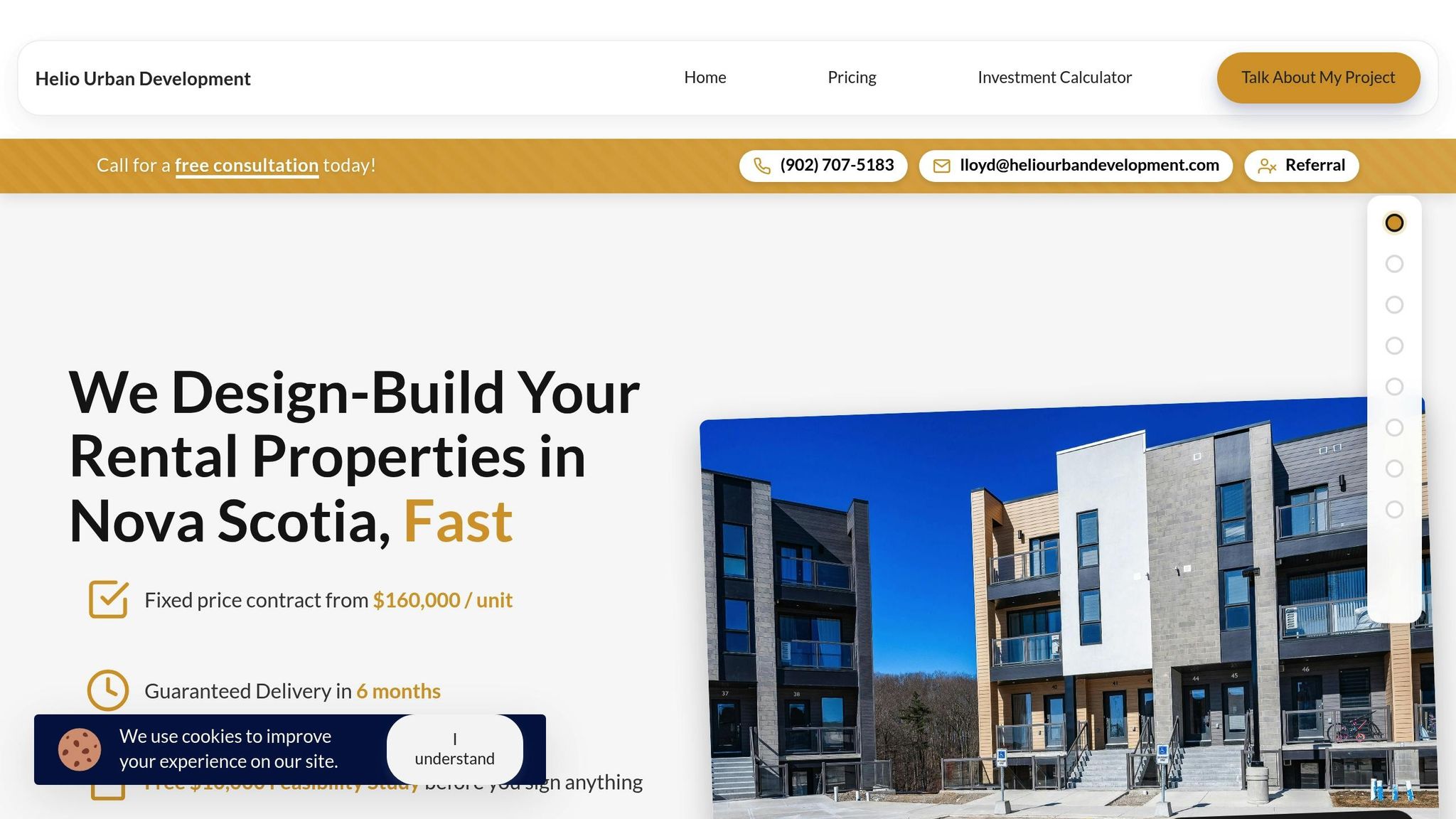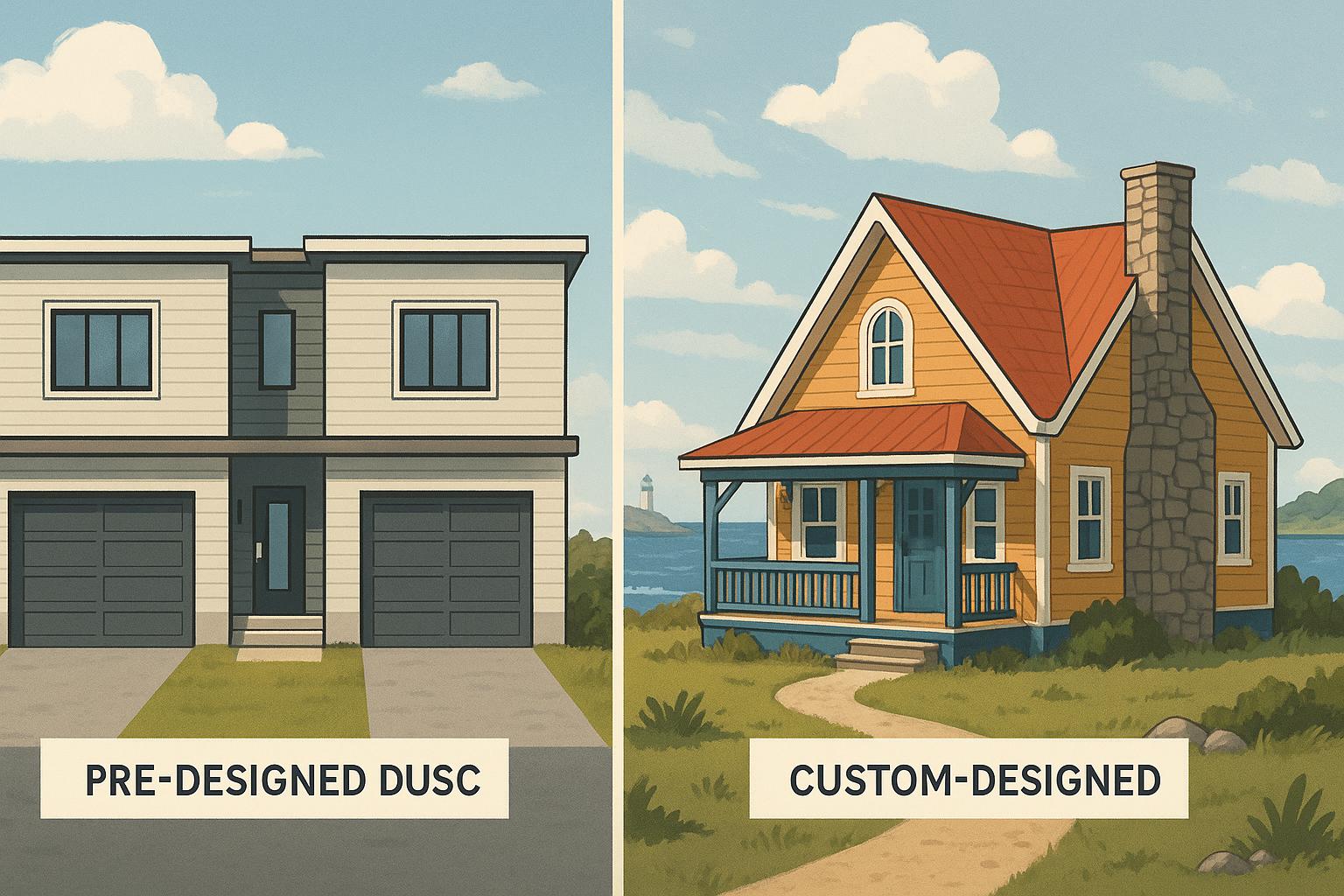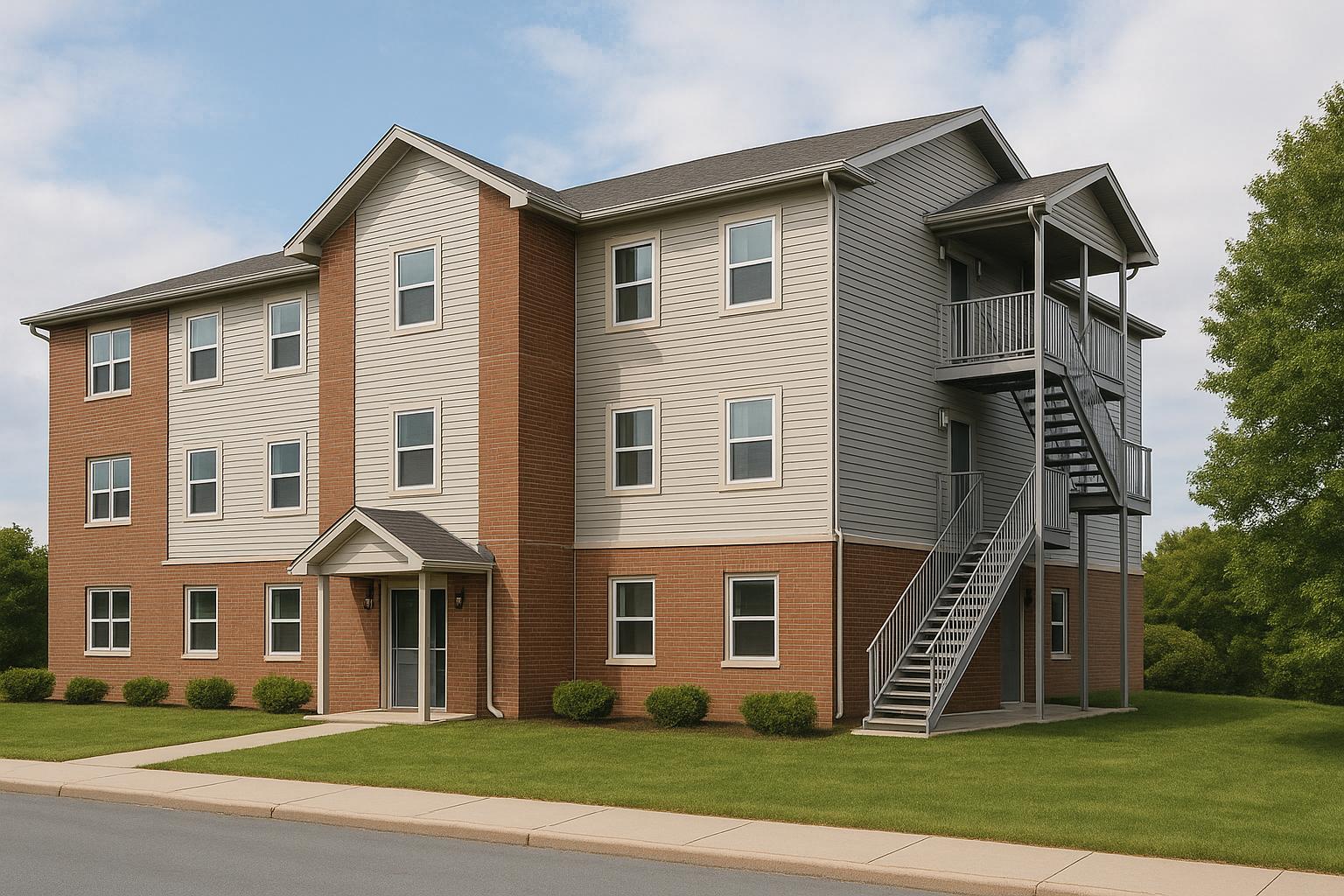Navigating Nova Scotia's multi-unit construction permit process can be frustrating, with delays caused by inconsistent documentation, zoning issues, and varying municipal requirements. Here’s how to avoid setbacks:
- Understand Local Rules: Each municipality has unique zoning, parking, and setback regulations. Early consultation with planning departments helps clarify requirements.
- Prepare Accurate Documents: Incomplete or inconsistent submissions (e.g., mismatched dimensions, missing accessibility features) often lead to rejections. Ensure all architectural, structural, and engineering plans align.
- Follow the Building Code: Multi-unit buildings must meet stringent fire safety, accessibility, and energy efficiency standards. Address these during the design phase.
- Use Professional Help: Integrated design-build teams streamline the process by aligning architects, engineers, and contractors, reducing revisions and delays.
Early planning, complete documentation, and professional coordination are key to faster permit approvals and controlled project timelines.
2. Introduction to Permitting, Planning, Licensing & Compliance - Customer Website
Know Your Municipal Requirements
Understanding municipal requirements is crucial to avoid unnecessary permit delays. While all municipalities in Nova Scotia follow the provincial building code, they also impose their own local regulations. These additional rules can significantly affect the timeline for your multi-unit construction project.
The process for obtaining permits varies greatly depending on the municipality. Larger urban centres often have more complex systems compared to smaller communities, and this inconsistency can lead to confusion. Misunderstanding local regulations frequently results in incomplete applications, which only adds to delays. Getting a clear grasp of these local rules early on ensures you meet both provincial and municipal standards without unnecessary setbacks.
It’s a good idea to reach out to your local municipal planning department. Most municipalities have staff available to guide you through their specific requirements for multi-unit construction. This step not only clarifies what documents you’ll need but also helps you understand their preferred formats and submission procedures.
Nova Scotia Building Code Requirements
The Nova Scotia Building Code Regulations, established under the Provincial Building Code Act, set the baseline standards for construction across the province. For multi-unit residential buildings, these regulations cover a wide range of requirements, including structural integrity, fire safety, and accessibility.
Buildings with four or more units typically fall under Part 3 of the building code, which has stricter guidelines compared to single-family homes. For example, you’ll need to meet specific fire separation standards between units, ensure proper emergency exits, and install commercial-grade mechanical ventilation systems.
Accessibility is another key consideration. Features like barrier-free entrances, 810 mm-wide doors, and accessible washrooms are mandatory for buildings with four or more units. These elements must be integrated into your design from the outset, as they are difficult to alter once plans are submitted.
Energy efficiency is also a priority under the building code. Your building’s envelope needs to meet specific thermal resistance values, and mechanical systems must achieve minimum efficiency ratings. In many cases, you’ll need to include detailed energy modelling reports with your permit application to demonstrate compliance.
Additionally, fire safety measures such as fire separation, emergency exits, and - depending on the building’s height and occupancy - fire alarms, sprinkler systems, and emergency lighting are required. Addressing these standards during the design phase can save you from costly revisions and delays later on.
Local By-Laws and Zoning Rules
Municipal by-laws and zoning regulations introduce another layer of complexity to the permitting process. These rules dictate where you can build, the size of your building, and specific design elements that must be included - or avoided. While the building code sets the foundation, local by-laws fine-tune the requirements for your project.
Zoning classifications differ significantly between municipalities. For instance, an R-2 (medium density residential) zone in Halifax may allow for a different number of units than the same classification in Dartmouth or Sydney. These variations can directly impact the density and feasibility of your project.
Parking requirements are another important consideration. In Halifax, most multi-unit buildings require 1.25 parking spaces per unit, while smaller municipalities may demand two spaces per unit. These rules can influence your site layout and even the overall viability of your project.
Setbacks, or the required distance between your building and property lines, also vary widely. For example, some municipalities mandate a 7.5-metre front setback, while others allow buildings as close as 4.5 metres to the street. These differences can significantly affect your building’s placement on the lot.
Height restrictions can further complicate your design. Many municipalities cap multi-unit buildings at three storeys or 11 metres, though these limits can vary depending on zoning and proximity to single-family homes. In some areas, additional rules around roof pitch or architectural style may also come into play.
Finally, landscaping and green space requirements add another layer of detail. Some municipalities require that 30% of your lot remain landscaped, while others prioritize tree preservation or stormwater management. These rules may necessitate professional landscaping plans as part of your permit application.
Submit Complete and Accurate Documentation
Once you’ve familiarized yourself with municipal requirements, the next step is submitting complete and precise documentation. Missing or incorrect paperwork is one of the main reasons for permit delays in Nova Scotia. Municipal offices handle hundreds of applications monthly, and staff simply don’t have the bandwidth to chase down missing details. If your application isn’t fully prepared, it’ll be sent back for revisions, potentially adding weeks - or even months - to your timeline.
To avoid these setbacks, ensure all documents meet municipal standards. For digital submissions, use high-resolution files, proper formatting, and clear labelling. A well-organized, digital-ready submission can drastically reduce the back-and-forth.
Required Documents for Permit Applications
For multi-unit construction projects in Nova Scotia, specific documents are mandatory for permit approval. While requirements may vary slightly between municipalities, the following are typically essential for buildings with four or more units:
- Architectural drawings: These include detailed floor plans, elevations, and room dimensions. Each floor plan should specify the square metre size of individual rooms and total unit areas. Building elevations must show all four sides of the structure, with materials and finishes clearly labelled.
- Site plans: These provide context for your project, showing property boundaries, setbacks, existing and proposed buildings, parking areas, and landscaping. Include a north arrow, scale, and accurate dimensions. Many municipalities also require topographical details showing current and proposed grade levels.
- Structural drawings: Prepared by a licensed engineer, these must include foundation plans, framing details, and load calculations. Ensure the drawings are stamped by an engineer registered in Nova Scotia.
- Building cross-sections: These illustrate the internal structure, showing floor-to-ceiling heights, structural elements, and mechanical systems. Cross-sections are especially important for demonstrating compliance with fire separation requirements between units.
- Mechanical, electrical, and plumbing (MEP) drawings: These outline building systems. Mechanical drawings should detail heating, ventilation, and air conditioning systems, while electrical drawings need to show panel locations, circuit layouts, and lighting plans. Plumbing drawings must cover water supply lines, drainage systems, and fixture placements.
- Energy compliance reports: These demonstrate that your building meets Nova Scotia’s energy efficiency standards. Reports typically include thermal performance calculations and mechanical system efficiency ratings. Some municipalities may also request energy modelling software outputs to show projected energy consumption.
- Professional reports: Depending on site conditions, additional reports may be required. A geotechnical report is often necessary to assess soil conditions and foundation needs. If there are environmental concerns, a Phase I Environmental Site Assessment might be needed. Properties with heritage designations require heritage impact assessments.
Having these documents ready is crucial, but even well-prepared submissions can encounter issues if common mistakes aren’t addressed.
Common Documentation Mistakes to Avoid
Errors in your documentation can undermine even the strongest application. By understanding common pitfalls, you can avoid unnecessary delays and keep your project on track.
- Inconsistent dimensions: A frequent issue arises when measurements differ across drawings. For instance, if your site plan shows a building footprint of 15 metres by 20 metres, but your floor plans suggest otherwise, reviewers will flag it. Ensure all measurements align and reference the same datum points.
- Missing accessibility features: Multi-unit projects often fail to include required 810 mm-wide doorways, accessible washroom layouts, or barrier-free entrances. These features must be clearly shown on floor plans and elevations - not just mentioned in specifications.
- Incomplete parking calculations: Parking requirements are another common stumbling block. Your site plan must clearly show the required number of spaces based on local by-laws. For example, if 1.25 spaces per unit are required for an eight-unit building, you’ll need 10 spaces. Show this calculation explicitly on your plans.
- Inadequate fire separation details: For multi-unit buildings, fire-rated assemblies between units must be clearly defined. Simply labelling a wall as "fire-rated" isn’t enough. Specify the exact assembly type and fire rating duration.
- Low-resolution drawings: Poor-quality scanned drawings can derail your application. Blurry or pixelated files make it hard for reviewers to interpret details. Always submit high-resolution PDFs with clear line weights and legible text.
- Outdated survey information: Using old surveys can lead to zoning conflicts. Ensure your survey plan is recent - ideally within the past two years - and prepared by a licensed Nova Scotia Land Surveyor.
- Inconsistent project information: All documents must align on details like the building’s address, legal description, and project scope. Even small discrepancies, such as differing unit counts, can raise red flags.
The best way to avoid these mistakes is by creating a customized checklist tailored to your municipality. Contact the local planning department to confirm exact requirements and preferred formats. Ensure all drawings are high-resolution and include professional seals and signatures. Taking these steps upfront will save you time and frustration down the line.
sbb-itb-16b8a48
Use Professional Support for Faster Approvals
Getting through Nova Scotia's permit approval process can feel like navigating a maze. But when you work with professionals who understand municipal requirements, it becomes far more manageable. Partnering with an integrated team simplifies the process by bringing design, engineering, and construction under one roof.
Take this scenario: an architect submits drawings, but they haven’t been fully reviewed by a structural engineer. Or perhaps buildability issues crop up after permits are approved. These situations often lead to expensive revisions and resubmissions. An integrated team can help avoid these headaches by addressing potential issues upfront.
Benefits of Integrated Design-Build Services
When planners, architects, engineers, and builders work together as a unified team, the permit approval process becomes smoother and more predictable. Integrated design-build services align everyone from the start, which can significantly reduce costly revisions later on.
This approach is especially helpful during the pre-submission phase. Many projects face repeated rounds of revisions because design and engineering considerations don’t always align. With an integrated team, these issues are resolved before the application even reaches the municipal office.
Another advantage? Strong relationships with local municipalities. Firms that frequently work with the same municipal offices gain valuable insights into their specific preferences and processes. This familiarity can help speed up approvals and minimize delays.
Quality control also gets a boost. When the same team handles both permits and construction, they’re invested in ensuring designs are accurate and feasible. Companies like Helio Urban Development have embraced this integrated approach, making the process more efficient for property owners.
How Helio Urban Development Handles Permit Challenges

Helio Urban Development, the only design-build company in Nova Scotia that specializes in multi-unit rental properties, is a prime example of how professional coordination can streamline permit approvals. They bring planners, architects, engineers, and construction teams together under one roof, cutting through the usual coordination chaos that can trip up property owners working on fourplexes or larger rental projects.
Helio offers fixed-price guarantees, locking in construction costs at $160,000 per unit. This pricing includes navigating permit requirements and handling any revisions needed during the approval process, giving property owners peace of mind about their budgets.
They also commit to timeline accountability with a 6-month construction guarantee, which includes financial penalties of up to $1,000 per day for delays. From the initial permit application to final occupancy approvals, Helio manages every step, ensuring projects stay on track.
Their deep familiarity with Nova Scotia’s regulatory landscape is another big plus. With projects spanning the Halifax region and beyond, Helio’s team understands the nuances of different municipalities’ requirements, helping move applications forward efficiently.
Transparency is a priority, too. Helio provides daily photo updates and real-time project portals, so property owners are always in the loop about permit statuses and construction progress.
Helio also ensures high standards with a triple quality verification system. Permit applications are prepared to meet not just basic requirements but bank-grade standards. During construction, a Professional Engineer conducts five inspections, and property owners can even select their final inspector for added confidence. This rigorous process is backed by a 2-year warranty, offering reassurance to both property owners and municipal reviewers.
For those pursuing CMHC MLI Select financing, Helio takes care of the extra documentation and energy efficiency requirements needed to qualify for 95% financing with a 50-year amortization. At $200,000 per unit, Helio’s integrated approach ensures that even complex permit applications are handled efficiently, keeping timelines intact - critical for financing approvals.
Best Practices for Faster Permit Processing
Taking the right steps early can speed up permit approvals and cut down on unnecessary delays. Municipal staff are invested in the success of projects, but they need clear, complete information to process applications efficiently. Let’s dive into some practical ways to shorten your timeline, starting with early engagement and strategic planning.
Contact Municipal Officials Early
In addition to understanding local regulations, reaching out to municipal planning departments early can save you time and money. Pre-application consultations are a great way to flag potential issues - like setbacks, parking requirements, or stormwater management - before they turn into expensive roadblocks.
These early conversations also help you understand which departments will need to review your application and the exact documents they’ll require. Building a relationship with municipal staff can make a big difference. When planners are familiar with your project and understand your objectives, they’re more likely to prioritize your application and offer helpful advice when challenges arise.
Some municipalities even provide expedited review options for complete applications that meet specific criteria. For example, Halifax Regional Municipality offers streamlined approval processes for certain multi-unit developments. Learning about such programs early can shave significant time off your approval process.
Use Technology for Better Project Planning
Modern project management tools can help you coordinate permit applications and construction timelines more effectively. Instead of relying on guesswork, these tools align tasks and adjust schedules automatically to prevent bottlenecks.
For instance, if structural drawings need revisions, the system recalibrates dependent tasks - like mechanical or electrical design - so the entire team stays in sync. This is especially useful during the permit phase, where unforeseen changes can arise. If the municipality requests updates to parking layouts, the technology adjusts timelines instantly, keeping everyone on track.
Companies like Helio Urban Development have developed custom scheduling systems that manage every stage of a project, from initial permits to final occupancy. These systems help avoid the typical delays that stretch projects from 12 to 18 months by ensuring seamless coordination between design, engineering, and construction teams.
Real-time tracking tools also keep property owners informed about their permit status. Instead of waiting in the dark, owners receive daily updates and can address issues as soon as they arise, minimizing potential setbacks.
Lock in Construction Costs with Fixed-Price Contracts
Efficient planning and communication go hand in hand with budget certainty. One way to manage financial risks during the permit process is by using fixed-price construction contracts. These contracts guarantee costs, even if the municipality requires additional studies or design changes, giving you peace of mind.
Traditional cost-plus contracts often leave property owners exposed to budget overruns, which can disrupt financing and jeopardize the project. Fixed-price contracts, however, shift the financial risk to experienced builders, ensuring permits are handled accurately and without unnecessary delays.
For example, Helio Urban Development offers a fixed-price model at $160,000 per unit, which includes managing all permit requirements and any revisions during the approval process. This approach not only provides budget certainty but also motivates builders to work efficiently through the permit system.
Additionally, penalties for delays - such as $1,000 per day - encourage builders to maintain strong relationships with municipal offices and submit well-prepared applications. This ensures smoother approvals and keeps your project on schedule.
Key Steps for Smooth Permit Approvals
Getting permits approved can feel like navigating a maze, but with the right preparation, expertise, and streamlined processes, it doesn’t have to be a headache. Property owners who understand municipal requirements, submit complete documentation, and collaborate with experienced professionals see faster results.
The process starts with early engagement with municipal authorities. This step ensures you understand the specific requirements and can address them upfront. Submitting complete and accurate documentation from the get-go is equally crucial.
Another key factor? Professional expertise. Municipal staff often encounter applications riddled with inconsistencies between architectural drawings and engineering plans. These errors lead to back-and-forth corrections, adding weeks - or even months - to the approval timeline.
This is where integrated design-build services shine. By bringing planners, architects, and engineers together under one roof, these services eliminate coordination issues. For example, Helio Urban Development’s integrated model has proven that combining design and engineering right from the start minimizes revisions. Their in-house team ensures compliance with zoning bylaws, building codes, and municipal standards, which supports their six-month construction guarantee.
To illustrate the difference between fragmented and integrated approaches, consider this:
| Fragmented Approach | Integrated Approach |
|---|---|
| 12–18 months typical timeline | 6 months guaranteed |
| Multiple revision cycles | Minimal revisions due to coordination |
| Cost increases of 30–60% | Fixed pricing with no overruns |
| Divided accountability | Single point of responsibility |
Financial control is another critical element. Fixed-price contracts not only help manage costs but also create accountability. For instance, Helio’s fixed-price model of $160,000 per unit covers all permit requirements. They even include penalties of up to $1,000 per day for missed deadlines. This approach motivates builders to maintain strong relationships with municipal offices and submit well-prepared applications.
Technology also plays a role in streamlining the process. Improved communication tools help align permit applications with construction timelines, ensuring everything runs smoothly.
Ultimately, clear and complete submissions are what municipal staff need to process applications efficiently. When property owners combine professional preparation, early communication, and integrated construction methods, they set themselves up for faster approvals and a smoother overall experience.
FAQs
What are the key mistakes to avoid when applying for permits for multi-unit construction in Nova Scotia?
Submitting an application with missing or incorrect information is a common misstep for property owners navigating the permit process. This could mean leaving out essential documents, making mistakes on forms, or overlooking specific municipal requirements.
Another frequent challenge is misunderstanding local rules or development restrictions, which can differ significantly from one municipality to another. Taking the time to research zoning laws and by-laws - and connecting with municipal authorities early on - can save you from unnecessary delays or complications.
Lastly, failing to include detailed plans and necessary supporting studies often results in setbacks. Submitting a complete, accurate application that meets local guidelines is key to keeping your project moving forward without unnecessary hiccups.
How does working with an integrated design-build team simplify the permit approval process for multi-unit projects in Nova Scotia?
An integrated design-build team makes the permit approval process much smoother by bringing together design and construction expertise from the very beginning. This teamwork ensures that municipal requirements are tackled early on, cutting down on the need for revisions and avoiding delays caused by missing or incorrect paperwork.
When design and construction efforts are aligned, communication flows better, and expectations are set clearly. This efficient approach helps secure permits faster, keeping your multi-unit project moving forward and on schedule.
What local zoning rules and by-laws should I know about for multi-unit construction projects in Nova Scotia?
Zoning rules and by-laws in Nova Scotia differ across municipalities, categorizing areas into zones like Residential (R-1, R-2, R-3), Mixed-Use (MU), and Commercial (C-1, C-2). For multi-unit developments, zones such as R-2 and R-3 typically permit two or more units. However, these zones often come with specific requirements, including setbacks, parking provisions, and density restrictions.
Each municipality has its own land-use by-laws and planning strategies that outline zoning regulations, building permit processes, and development standards. To avoid potential delays, it’s a good idea to consult your municipality’s planning office or review zoning maps to verify the rules that apply to your project’s location. Taking these steps early on can make the approval process much smoother.



